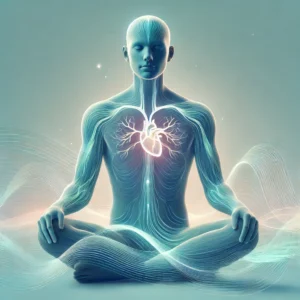Breathwork: Unlocking the Power of Your Breath for Holistic Well-being Welcome to ADDA YOGA Canggu, your sanctuary for holistic wellness in the heart of Bali. Today, we're diving deep into the transformative world of breathwork, a practice that has been gaining significant attention for its profound impact on both physical and mental health. Whether you're …
Breathwork: Unlocking the Power of Your Breath for Holistic Well-being
Welcome to ADDA YOGA Canggu, your sanctuary for holistic wellness in the heart of Bali. Today, we’re diving deep into the transformative world of breathwork, a practice that has been gaining significant attention for its profound impact on both physical and mental health. Whether you’re a seasoned yogi or new to the practice, understanding and incorporating breathwork into your daily routine can be a game-changer for your overall well-being.

What is Breathwork?
Breathwork is an ancient practice that involves conscious control of breathing patterns to improve mental, physical, and spiritual well-being . It’s a powerful tool that has been used for thousands of years across various cultures and traditions, from the yogic practices of India to the Taoist traditions of China. In essence, breathwork is a form of active meditation that uses different breathing techniques to influence our body’s physiological state and, consequently, our mental and emotional states. Alternate Nostril Breathing, a common breathwork technique. At its core, breathwork is about becoming aware of your breath and using it as a tool to regulate your nervous system.
By consciously changing our breathing patterns, we can tap into the body’s innate ability to heal and balance itself. This practice goes beyond simply taking deep breaths; it involves specific techniques designed to alter our physiological state, leading to a cascade of positive effects on our health and well-being .
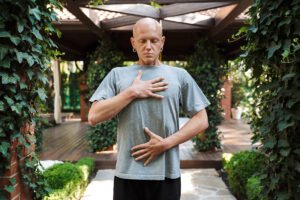
The Science Behind Breathwork
To understand why breathwork is so effective, we need to look at its impact on our autonomic nervous system. This system controls many of our body’s involuntary functions, including heart rate, digestion, and respiratory rate. It’s divided into two main branches:
- The sympathetic nervous system (our “fight or flight” response)
- The parasympathetic nervous system (our “rest and digest” state)
Breathwork, particularly slow, deep breathing exercises, activates the parasympathetic nervous system, which helps to counteract the effects of stress and promote relaxation . This activation leads to a decrease in heart rate, lower blood pressure, and a reduction in the production of stress hormones like cortisol.Recent studies have shown that regular breathwork practice can lead to significant improvements in both physical and mental health. A systematic review of breathwork interventions found that these practices can effectively reduce symptoms of anxiety, depression, and stress while improving overall well-being .

Benefits of Breathwork
The benefits of incorporating breathwork into your daily routine are vast and varied. Let’s explore some of the key advantages that make breathwork such a powerful tool for holistic health:
Physical Health Benefits
- Improved Immune System Function: Breathwork enhances the immune system by reducing systemic inflammation and improving oxygen intake. Dr. Jeremy Montrose explains that proper breathing techniques can strengthen our body’s defense mechanisms .
- Lower Blood Pressure: Regular breathwork practice has been shown to lower blood pressure by activating the parasympathetic nervous system, which dilates blood vessels and reduces heart rate .
- Enhanced Lung Capacity: Breathwork exercises can significantly improve lung function, particularly beneficial for individuals with chronic obstructive pulmonary disease (COPD) or asthma. A 2016 study demonstrated improved lung capacity in elderly smokers who practiced breathing exercises .
- Better Blood Circulation: Deep breathing techniques promote better blood flow throughout the body, ensuring that organs and tissues receive adequate oxygen and nutrients .
- Pain Management: Breathwork can be an effective tool for managing chronic pain. A 2012 study found that participants practicing relaxing breathing techniques experienced reduced stress and negative emotions associated with chronic pain .
- Detoxification: By enhancing lymphatic system efficiency and increasing oxygen-rich blood circulation, breathwork aids in the body’s natural detoxification processes .

Mental Health Benefits
- Stress and Anxiety Reduction: One of the most significant benefits of breathwork is its ability to reduce stress and anxiety. By activating the parasympathetic nervous system, breathwork helps to complete the stress cycle, calming the fight-or-flight response and grounding individuals in the present moment .
- Mood Enhancement: Breathwork can improve mood and emotional well-being by reducing cortisol levels associated with stress and anxiety. Techniques like alternate nostril breathing and Pranayama are particularly effective in promoting relaxation and a sense of peace .
- Improved Sleep Quality: Regular breathwork practice can aid in better sleep by regulating energy levels and promoting relaxation. A 2018 study found that self-regulated breathing was more effective than pharmaceutical methods in helping individuals with insomnia fall asleep .
- Depression Management: When combined with other treatments, breathwork can be an effective tool in managing depression. It helps alter mood and ground individuals in the present moment, as highlighted by a 2016 study from the Perelman School of Medicine .
- Enhanced Cognitive Function: By increasing oxygen flow to the brain, breathwork can improve cognitive function, mental clarity, and focus while reducing mental fatigue .
- Emotional Regulation: Breathwork provides a powerful means of regulating emotions, helping individuals to process and release negative feelings more effectively .

Types of Breathwork Techniques
There are numerous breathwork techniques, each with its own specific effects and benefits. Here are some of the most popular and effective methods:
- Diaphragmatic Breathing (Belly Breathing)
Diaphragmatic breathing, also known as belly breathing or abdominal breathing, is a fundamental breathwork technique that forms the basis of many other practices. This method involves deep breathing that engages the diaphragm, the primary muscle responsible for respiration .
How to practice:
- Lie down or sit comfortably with one hand on your chest and the other on your belly.
- Inhale slowly through your nose, allowing your belly to rise while keeping your chest relatively still.
- Exhale slowly through pursed lips, feeling your belly lower.
- Repeat for 5-10 minutes.
Benefits: Diaphragmatic breathing helps lower blood pressure and heart rate, making it particularly beneficial for individuals with lung conditions or those looking to reduce stress .
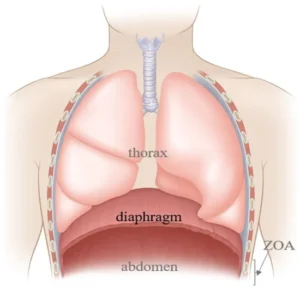
Box Breathing
Box breathing, also known as square breathing, is a simple yet powerful technique that involves four equal phases of breathing. It’s often used in high-pressure situations to manage stress and improve concentration .How to practice:
- Inhale slowly for a count of four.
- Hold your breath for a count of four.
- Exhale slowly for a count of four.
- Hold your breath again for a count of four.
- Repeat this cycle for 5-10 minutes.
Benefits: Box breathing is excellent for calming the nervous system, reducing stress, and enhancing focus and concentration .
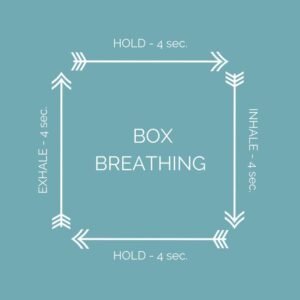
Alternate Nostril Breathing (Nadi Shodhana)
Alternate nostril breathing, or Nadi Shodhana in Sanskrit, is a yogic practice that involves breathing through one nostril at a time. This technique is believed to balance the left and right hemispheres of the brain .How to practice:
- Sit comfortably with your left hand on your lap and the right thumb near your nose.
- Close your right nostril with your right thumb and inhale through the left nostril.
- Close the left nostril with your ring finger and release the right nostril, exhaling through the right side.
- Inhale through the right nostril.
- Close the right nostril and exhale through the left.
- This completes one cycle. Repeat for 5-10 minutes.
Benefits: Alternate nostril breathing is known to enhance focus, reduce stress, and balance the autonomic nervous system .

4- ) The 4-7-8 Breathing Technique
Developed by Dr. Andrew Weil, the 4-7-8 breathing technique is designed to promote relaxation and reduce anxiety by regulating the nervous system .
How to practice:
- Inhale quietly through your nose for a count of four.
- Hold your breath for a count of seven.
- Exhale completely through your mouth, making a whoosh sound, for a count of eight.
- Repeat this cycle for four breaths.
Benefits: This technique is particularly effective for reducing anxiety, managing stress, and promoting better sleep .

Holotropic Breathwork
Holotropic breathwork is a more advanced technique that involves rapid and controlled breathing to achieve an altered state of consciousness. It’s typically conducted in group settings with a trained facilitator .How to practice: Due to its intensity, holotropic breathwork should only be practiced under the guidance of a certified practitioner. It involves lying down and breathing deeply and rapidly for extended periods, often accompanied by evocative music.
Benefits: Holotropic breathwork is used for self-exploration, personal growth, and emotional healing .

Wim Hof Method
The Wim Hof Method, developed by Dutch extreme athlete Wim Hof, combines breathing exercises with cold exposure and meditation. It’s gained popularity for its potential to improve physical and mental resilience .
How to practice:
- Sit comfortably and take 30-40 deep breaths, inhaling through the nose and exhaling through the mouth.
- After the last exhale, hold your breath for as long as you can.
- When you need to breathe, take a deep breath and hold it for 15-20 seconds.
- Repeat this cycle 3-4 times.
Benefits: Practitioners report increased energy, reduced stress levels, and enhanced immune function .
 Incorporating Breathwork into Your Daily Routine
Incorporating Breathwork into Your Daily Routine
Now that we’ve explored the various types of breathwork, you might be wondering how to incorporate these practices into your daily life. Here are some tips to help you get started:
- Start Small: Begin with just 5-10 minutes of breathwork each day. You can gradually increase the duration as you become more comfortable with the practice.
- Choose a Consistent Time: Try to practice at the same time each day to establish a routine. Many people find it helpful to do breathwork first thing in the morning or before bed.
- Create a Dedicated Space: Designate a quiet, comfortable area in your home for your breathwork practice. This could be a corner of your bedroom or a spot in your garden.
- Use Guided Sessions: If you’re new to breathwork, consider using guided sessions or apps to help you get started. Many yoga and meditation apps offer breathwork exercises.
- Combine with Other Practices: Breathwork can be easily integrated into other mindfulness practices like yoga or meditation. At ADDA YOGA Canggu, we offer classes that combine breathwork with various yoga styles.
- Be Patient: Like any new skill, breathwork takes time to master. Be patient with yourself and remember that consistency is key.
- Listen to Your Body: Always pay attention to how your body responds to different techniques. If you feel lightheaded or uncomfortable, return to your normal breathing pattern.

The Role of Breathwork in Yoga Practice
In the context of yoga, breathwork (pranayama) is considered one of the eight limbs of yoga, highlighting its importance in the holistic practice.
Breathwork serves as a bridge between the physical aspects of yoga (asanas) and the mental aspects (meditation) .Incorporating breathwork into your yoga practice can:
- Deepen your postures by creating more space in the body
- Enhance your focus and presence on the mat
- Help you manage challenging poses by regulating your breath
- Increase the overall benefits of your yoga practice by activating the parasympathetic nervous system
At ADDA YOGA Canggu, we integrate various breathwork techniques into our classes, allowing you to experience the synergistic benefits of combining breath awareness with physical postures.
Precautions and Considerations
While breathwork is generally safe for most people, there are some precautions to keep in mind:
- Medical Conditions: If you have any respiratory conditions, cardiovascular issues, or are pregnant, consult with a healthcare provider before starting a breathwork practice.
- Intensity: Some techniques, like holotropic breathwork, can be intense and should only be practiced under professional guidance.
- Dizziness: If you feel dizzy or lightheaded during practice, return to normal breathing and stop if necessary.
- Overbreathing: Be cautious not to overbreathe, as this can lead to hyperventilation. Always follow the recommended duration for each technique.
- Emotional Release: Breathwork can sometimes trigger emotional releases. If you’re dealing with trauma or significant emotional issues, it’s advisable to work with a trained professional.
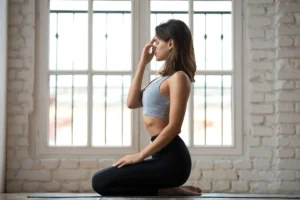
Conclusion: Breathe Your Way to Better Health
Breathwork is a powerful, accessible tool for improving both physical and mental health. From reducing stress and anxiety to enhancing immune function and promoting better sleep, the benefits of regular breathwork practice are profound and far-reaching.At ADDA YOGA Canggu, we believe in the transformative power of breath.
We invite you to explore our range of classes that incorporate various breathwork techniques, allowing you to experience firsthand the incredible benefits of this ancient practice in the serene setting of Bali.Remember, your breath is always with you, making breathwork a practice you can turn to anytime, anywhere. By becoming more aware of your breath and learning to use it effectively, you’re taking a significant step towards better health, greater peace of mind, and a more balanced life.
Join us at ADDA YOGA Canggu and discover how the simple act of conscious breathing can revolutionize your health and well-being. Let’s embark on this journey of self-discovery and transformation together, one breath at a time
Are you look for the best breathwork experience in Bali ?
We have different kind of breathwork classes or events : Pranayama, somatic, Quantum, Holotropic, Shamanic, rebirthing breathwork
We provide private breathwork classes in Bali too ( in your villa )
We serve all Bali ! Canggu, Seminyak , Ubud, Uluwatu. Sanur, Nusa Dua
English
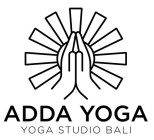




 Incorporating Breathwork into Your Daily Routine
Incorporating Breathwork into Your Daily Routine
